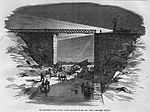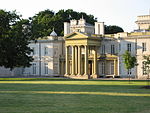Royal Botanical Gardens (RBG) is headquartered in Burlington owning extensive environmental protection areas, historic sites and culturally relevant gardens in Hamilton, Ontario, Canada. It is one of the major tourist attractions between Niagara Falls and Toronto, as well as a significant local and regional horticultural, education, conservation, and scientific resource. The mandate is derived by a Provincial Act of 1941 centred on human interaction with the natural world and protection of environmentally significant lands that form the western tip of Lake Ontario. Royal Botanical Gardens spans an area of about 10 km by 4 km, dominated by two coastal wetlands, and glacial-carved landscapes that extend from the lake up to the Niagara Escarpment plateau. The various gardens and natural areas are accessed through nine public entrance locations. It is one of several Prescribed Public Bodies listed under the Ontario Heritage Act.
In 2006, in support of the United Nations Convention on Biological Diversity, Royal Botanical Gardens was selected as Canada's National Focal Point for the Global Strategy for Plant Conservation (GSPC) by Environment and Climate Change Canada.The 980 hectares (2,422 acres) of nature sanctuary owned by the Royal Botanical Gardens is largely a remnant of the Dundas Marsh Game Preserve created in 1927. The properties now carry many cultural and environmental designations. Multiple national historic site features are associated with area, with the site featuring prominently as a landing and connection point to other regions of the Great Lakes. It is considered an important plant biodiversity hotspot for Canada, with a very high proportion of the wild plants of Canada in one area; is an Important Bird Area according to Bird Studies Canada; and is part of the Niagara Escarpment World Biosphere Reserve. More than 1,100 species of plants grow within its boundaries including the Bashful Bulrush (Trichophorum planifolium) which is found nowhere else in Canada, and the largest remaining population of one of Canada's most endangered trees, the Red Mulberry (Morus rubra). Both of these plants are listed as Endangered in Canada under the Species at Risk Act. In 2008, the RBG was designated as an Important Amphibian and Reptile Area by CARCNET, the Canadian Amphibian and Reptile Conservation Network. Several plants listed on various Endangered Species Protection programs are held for protection and education purposes in various garden areas.
Unusually Royal Botanical Gardens is both the owner of the land under Cootes Paradise and Grindstone Marsh as well as regulator of activities on the water, despite it being an inlet of Lake Ontario. Water area activity regulation was formerly under the Hamilton Harbour Commission (Now Hamilton Oshawa Port Authority) as part of the areas historical federal port regulation. In the late 1970s the Harbour Commission and Royal Botanical Gardens made an agreement transferring regulation of use of the water area to the Gardens in support of its environmental protection mandate. However, Royal Botanical Gardens has no regulatory control over the quality of water flowing into its wetlands.








